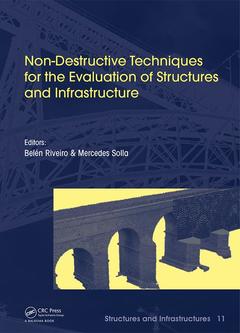Non-Destructive Techniques for the Evaluation of Structures and Infrastructure Structures and Infrastructures Series
Coordonnateurs : Riveiro Belén, Solla Mercedes

This book provides an overview and up-to-date synthesis of the most commonly used non-destructive technologies for the reverse engineering of built infrastructure facilities. These technologies tackle both the geometric and radiometric characterization of built structures, and thus, validated technologies such as laser scanning, photogrammetry, and multispectral remote sensing are presented in depth, from their fundamentals to their application to management systems for diverse applications in civil engineering (damage inspection, structural calculations, road inventory and inspections, BIM, etc.). Alternative methods are therefore presented for routine sub-surface inspections by using non-invasive geophysics (e.g. magnetic, electrical and electromagnetic), as well as thermography for the nearest sub-surface.
The book is divided into three sections, whose main features are as follows:
- Section 1: Fundamentals, principles and applications of: laser scanning, photogrammetry, geophysics, ground penetrating radar, IR thermography, multispectral imaging.
- Section 2: Applications to the inspection of infrastructure facilities: tunnels, breakwaters, railways, roads, and modeling of existing buildings (damage inspection in constructions, thermographic 3D modeling, structural modeling of industrial constructions).
- Section 3: new management tools and intelligent modeling: infrastructure management systems based on non-destructive technologies for masonry arch bridges, computational approaches for GPR processing and interpretation, automatic processing and object recognition from laser scanning data, BIM for existing buildings.
This cutting-edge edited volume will be a valuable resource for students, researchers and professional engineers with an interest in non-destructive technologies and their applications to reverse engineering of structures and infrastructure.
An Overview of Non-Destructive Techniques. Introduction. Laser Scanning Technology: Fundamentals, Principles and Applications in Infrastructure. Close Range Photogrammetry: Fundamentals, Principles and Applications in Infrastructure. Geophysics. Fundamentals and Applications in Structures and Infrastructure. Ground Penetrating Radar: Fundamentals, Methodologies and Applications in Structures and Infrastructure. Infrared Thermography. Fundamentals, Principles and Applications in Infrastructure. Multispectral Imaging: Fundamentals, Principles and Applications to Damage Assessment in Constructions. Geographic Information Systems: Fundaments and Applications in Infrastructure Management. Applications in Structures and Infrastructure. Non-Destructive Testing of Tunnels: Application of LiDAR and GPR Technologies. Breakwaters Monitoring using Geomatic and Hydrographic Technologies. The Use of Geophysics for the Condition Assessment of Rail Infrastructure. Applications of the GPR Method for Road Inspection. Thermographic 3D Modelling of Existing Constructions. Practical Use of Multispectral Techniques for the Detection of Pathologies in Cultural Heritage Façades. Non-Destructive Techniques Applied to Ancient Masonry Arch Bridges Assessment: Structural Diagnosis and Geometric Modeling. Providing Geometry for the Automatic Creation of Structural Models. Metallic Structures in Industrial Factories. As-Built and Structural. New Management Tools and Intelligent Modelling. Infrastructure Management Systems Based on Non-Destructive Techniques: Roads and Bridges. Advanced Computational Approaches for GPR Processing and Interpretation. New Challenges in Laser Scanning Data Processing: Automatic Processing of Data and Object Recognition. BIM as Management Tool for Existing Buildings.
Date de parution : 04-2016
17.4x24.6 cm
Thème de Non-Destructive Techniques for the Evaluation of... :
Mots-clés :
Point Cloud; Spain Applied Geotechnologies Research Group; point; GPR Data; cloud; Mobile LiDAR; university; Infrared Thermography; vigo; GPR; ground; LiDAR Data; penetrating; LiDAR Point Cloud; radar; Moisture Content; spain; Thermographic Images; applied; Riegl LMS Z-390i; geotechnologies; LiDAR System; Close Range Photogrammetry; Terrestrial Laser Scanner; Thermographic Inspection; Laser Scanner; Masonry Arch Bridges; GPR System; BMS; GPR Profile; Thermal Infrared; Masonry Bridge; GPR Method; Terrestrial LiDAR; Calibration Grid



